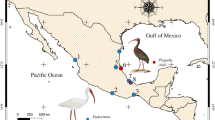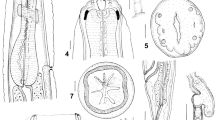Abstract
During a parasitological survey of Leucoraja erinacea, L. ocellata, Malacoraja senta and Amblyraja radiata from Passamaquoddy Bay and waters surrounding the West Isles of the Bay of Fundy, NB, Canada, seven species of cestodes were recovered. Examination of these skates revealed the presence of two distinct species of Pseudanthobothrium Baer, 1956: one was retrieved from M. senta and A. radiata, identified as P. hanseni Baer, 1956 and redescribed herein; the other was retrieved from L. erinacea and L. ocellata and differs from previously described species. The new species is described herein as P. purtoni n. sp. on the basis of the degree of apolysis, the maximum width of the strobila, the length of the cirrus-sac and the number of testes. Additionally, the distinctiveness of both species of Pseudanthobothrium is supported by the characterisation of a 643 base-pair nuclear marker, which includes most of the D2 variable region of the large subunit ribosomal DNA (LSU). The recovery of two different tetraphyllidean species, each from two different host species, challenges the oioxeny (strict host-specificity) of echeneibothriine cestodes and can be explained, at least in part, by the similarities in diet and substrate preference within each host pair.









Similar content being viewed by others
References
Agusti, C., Aznar, F. J., Olson, P. D., Littlewood, D. T. J., Kostadinova, A., & Raga, J. A. (2005). Morphological and molecular characterization of tetraphyllidean merocercoids (Platyhelminthes: Cestoda) of striped dolphins (Stenella coeruleoalba) from the Western Mediterranean. Parasitology, 130, 461–474.
Baer, J. G. (1956). Parasitic helminths collected in West Greenland. Meddelelser om Grønland Udgivne af Kommissionen for Videnskabelige Undersogelser i Grönland, 124, 1–55.
Baer, J. G. (1962). Cestoda. Zoology of Iceland, 2, 1–63.
Brickle, P., Olson, P. D., Littlewood, D. T. J., Bishop, A., & Arkhipkin, A. I. (2001). Parasites of Loligo gahi, with a phylogenetically based identification of their cestode larvae. Canadian Journal of Zoology, 79, 2289–2296.
Caira, J. N., Jensen, K., & Healy, C. J. (1999). On the phylogenetic relationships among tetraphyllidean, lecanicephalidean and diphyllidean tapeworm genera, Systematic Parasitology, 42, 77–151.
Caira, J. N., Jensen, K., & Healy, C. J. (2001). Interrelationships among tetraphyllidean and lecanicephalidean cestodes. In D. T. J. Littlewood & R. A. Bray (Eds.), Interrelationships of the Platyhelminthes (pp. 135–158). London: Taylor and Francis.
Devlin, C. M., Diamond, A. W., & Saunders, G. W. (2004). Sexing arctic terns in the field and laboratory. Waterbirds, 27, 314–320.
Euzet, L. (1994). Order Tetraphyllidea. In L. F. Khalil, A. Jones & R. A. Bray (Eds.), Keys to the cestode parasites in vertebrates (pp. 149–194). Wallingford: CAB International.
Gene Codes Corporation (2005) Sequencher, version 4.5. Ann Arbor, Michigan.
Harper, J. T., & Saunders, G. W. (2001). The application of sequences of the ribosomal cistron to the systematics and classification of the florideophyte red algae (Florideophyceae, Rhodophyta). Cahiers de Biologie Marine, 42, 25–38.
Heller, A. F. (1949). Parasites of cod and other marine fish from the Baie des Chaleurs region. Canadian Journal of Research, D, 27, 243–264.
Jarecka, L., & Burt, M. D. B. (1984). The cercoid larvae of Pseudanthobothrium hanseni Baer, 1956 and Pseudanthobothrium sp. (Cestoda: Tetraphyllidea) from experimentally infected harpacticoid copepods. Acta Parasitologica Polonica, 29, 23–26.
Keeling, C. P., & Burt, M. D. B. (1996). Echeneibothrium canadensis n. sp. (Tetraphyllidea: Phyllobothriidae) in the spiral intestine of the thorny skate (Raja radiata) from the Canadian Atlantic Ocean. Canadian Journal of Zoology, 74, 1590–1593.
Laurie, J. S. (1961). Carbohydrate absorption in cestodes from elasmobranch fishes. Comparative Biochemistry and Physiology, 4, 63–71.
Maddison, D. R., & Maddison, W. P. (2005). MacClade 4, version 4.07. Sunderland, Massachusetts: Sinauer Associates.
Margolis, L., & Arthur, J. R. (1979). Synopsis of the parasites of fishes of Canada. Bulletin of the Fisheries Research Board of Canada, 199, 269 pp.
Mariaux, J., & Olson, P. D. (2001). Cestode systematics in the molecular era. In D. T. J. Littlewood & R. A. Bray (Eds.), Interrelationships of the Platyhelminthes (pp. 127–134). London: Taylor & Francis.
McDonald, T. E., & Margolis, L. (1995). Synopsis of the parasites of fishes of Canada. Supplement (1978–1993). Canadian Special Publication of Fisheries and Aquatic Sciences, 122, 265 pp.
McEachran, J. D., & Dunn, K. A. (1998). Phylogenetic analysis of skates, a morphologically conservative clade of elasmobranchs (Chondrichthyes: Rajidae). Copeia, 1998, 271–290.
McEachran, J. D., & Musick, J. A. (1975). Distribution and relative abundance of seven species of skates (Pisces: Rajidae) which occur between Nova Scotia and Cape Hatteras. Fishery Bulletin (United States National Marine Fisheries Service), 75, 110–136.
McEachran, J. D., Boesh, D. F., & Musick, J. A. (1976). Food divisions within two sympatric species-pairs of skates (Pisces: Rajidae). Marine Biology, 35, 301–317.
Myers, B. J. (1959). Parasites from elasmobranch hosts from the Magdalen Islands region of the Gulf of St. Lawrence. Canadian Journal of Zoology, 37, 245–246.
Olson, P. D., Littlewood, D. T. J., Bray, R. A., & Mariaux, J. (2001). Interrelationships and evolution of the tapeworms (Platyhelminthes: Cestoda). Molecular Phylogenetics and Evolution, 19, 443–467.
Packer, D. B., Zetlin, C. A., & Vitaliano, J. J. (2003a). Little skate, Leucoraja erinacea, life history and habitat characteristics. NOAA Technical Memorandum NMFS-NE-175, 66 pp.
Packer, D. B., Zetlin, C. A., & Vitaliano, J. J. (2003b). Winter skate, Leucoraja ocellata, life history and habitat characteristics. NOAA Technical Memorandum NMFS-NE-179, 57 pp.
Packer, D. B., Zetlin, C. A., & Vitaliano, J. J. (2003c). Smooth skate, Malacoraja senta, life history and habitat characteristics. NOAA Technical Memorandum NMFS-NE-177, 26 pp.
Packer, D. B., Zetlin, C. A., & Vitaliano, J. J. (2003d). Thorny skate, Amblyraja radiata, life history and habitat characteristics. NOAA Technical Memorandum NMFS-NE-178, 39 pp.
Posada, D., & Buckley, T. R. (2004). Model selection and model averaging in phylogenetics: advantages of the AIC and Bayesian approaches over likelihood ratio tests. Systematic Biology, 53, 793–808.
Posada, D., & Crandall, K. A. (1998). Modeltest: testing the model of DNA substitution. Bioinformatics, 14, 817–818.
Randhawa, H. S., Saunders, G. W., & Burt, M. D. B. (2007). Establishment of the timing of host specificity in four phyllobothriid tapeworm species (Cestoda: Tetraphyllidea) using a molecular approach. Parasitology, 134, 1291–1300.
Reyda, F., & Olson, P. D. (2003). Cestodes of cestodes of Peruvian freshwater stingrays. Journal of Parasitology, 89, 1018–1024.
Saunders, G. W. (1993). Gel purification of red algal genomic DNA: an inexpensive and rapid method for the isolation of polymerase chain reaction-friendly DNA. Journal of Phycology, 29, 251–254.
Schmidt, G. D. (1986). Order Tetraphyllidea. In G. D. Schmidt (Ed.), Handbook of tapeworm identification (pp. 131–164). Boca Raton: CRC Press Inc.
Scott, W. B., & Scott, M. G. (1988). Atlantic Fishes of Canada. Canadian Bulletin of Fisheries and Aquatic Sciences, 219, 731 pp.
Swofford, D. L. (2002). PAUP* Phylogenetic analysis using parsimony (*and other methods), version 4.0b10. Sunderland, Massachusetts: Sinauer Associates.
Threlfall, W. (1969). Some parasites from elasmobranchs in Newfoundland. Journal of the Fisheries Research Board of Canada, 26, 805–811.
Williams, H. H. (1966). The ecology, functional morphology and taxonomy of Echeneibothrium Beneden, 1849 (Cestoda: Tetraphyllidea), a revision of the genus and comments on Discobothrium Beneden, 1870, Pseudanthobothrium Baer, 1956, and Phormobothrium Alexander, 1963. Parasitology, 56, 227–285.
Wojciechowska, A. (1990). Pseudanthobothrium shetlandicum sp. n. and P. notogeorgianum sp. n. (Tetraphyllidea) from rays in the regions of the South Shetlands and South Georgia (Antarctic). Acta Parasitologica Polonica, 35, 181–186.
Wojciechowska, A. (1991). Some tetraphyllidean and diphyllidean cestodes from Antarctic batoid fishes. Acta Parasitologica Polonica, 36, 69–74.
Acknowledgements
Special thanks are due to J. N. Caira, H. H. Williams and C. P. Keeling for encouraging the senior author to pursue a career in parasitology and to work on tetraphyllidean worms, and also for their hospitality and advice. The authors are grateful to staff of the HMSC: F. Purton and D. Parker for their technical assistance and availability; T. Hurley and M. Burgess for assisting with collection of specimens; and E. Carter who went beyond the call of duty as Captain of the R/V ‘W. B. Scott’. The help of D. Loveless and W. Minor Mate/Engineer and Captain of the CCGS ‘Pandalus III’, respectively, in collecting by Department of Fisheries and Oceans Canada (DFO) personnel, is also gratefully acknowledged. We thank S. Belfry of the Electron Microscopy Unit at the University of New Brunswick, who was instrumental in teaching the senior author the essentials of scanning electron microscopy and assisted in the preparation of the material. The senior author thanks C. E. Lane and L. LeGall as well as T. Moore and M. Surette for their technical assistance and advice regarding molecular methodologies. We are most grateful to A. R. Breton and two anonymous and diligent reviewers for providing useful comments on this manuscript. The Institute of Parasitology of McGill University, the HMSC and the Department of Biology of the University of New Brunswick (UNB) provided lab space and other research facilities. The following financial assistance is gratefully acknowledged: Graduate Teaching and Research Assistantships at UNB, two McGill R. C. Frazee Research Scholarships at HMSC, one UNB R. C. Frazee Research Scholarship at HMSC, a W. B. Scott Graduate Research Scholarship in Ichthyology, and two HMSC Summer Student Assistantships to the senior author. In addition, the Natural Sciences and Engineering Research Council of Canada (NSERC) provided assistance through operating/discovery grants to Drs G. W. Saunders, M. E. Scott and M. D. B. Burt; a Steacie Fellowship to G. W. Saunders; and a Major Facilities Access Grant to HMSC. The Canada Research Chairs Program (G. W. Saunders) also provided financial assistance.
Author information
Authors and Affiliations
Corresponding author
Rights and permissions
About this article
Cite this article
Randhawa, H.S., Saunders, G.W., Scott, M.E. et al. Redescription of Pseudanthobothrium hanseni Baer, 1956 and description of P. purtoni n. sp. (Cestoda: Tetraphyllidea) from different pairs of rajid skate hosts, with comments on the host-specificity of the genus in the northwest Atlantic. Syst Parasitol 70, 41–60 (2008). https://doi.org/10.1007/s11230-007-9122-6
Received:
Accepted:
Published:
Issue Date:
DOI: https://doi.org/10.1007/s11230-007-9122-6




